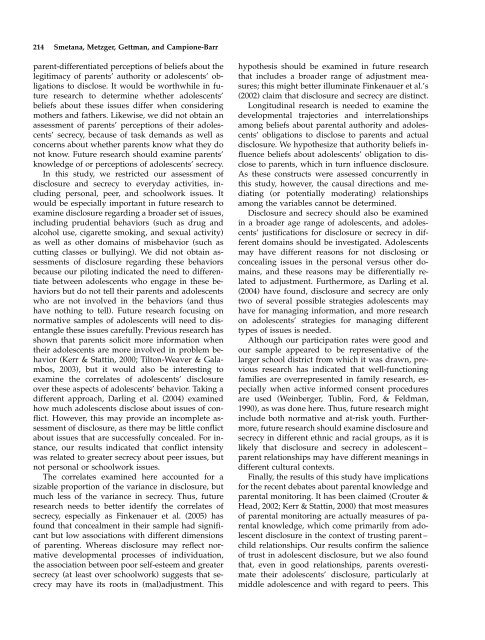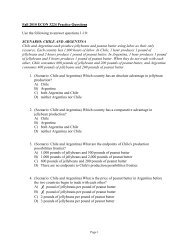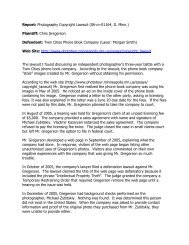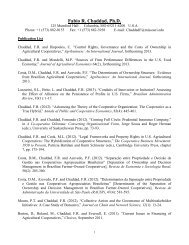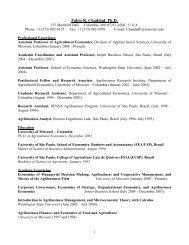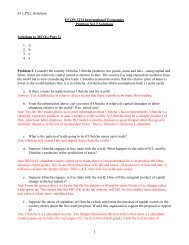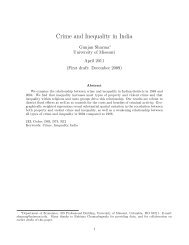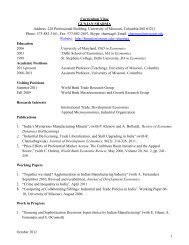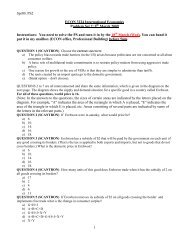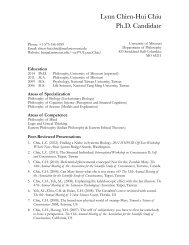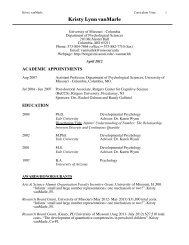Disclosure and Secrecy in Adolescent–Parent Relationships
Disclosure and Secrecy in Adolescent–Parent Relationships
Disclosure and Secrecy in Adolescent–Parent Relationships
Create successful ePaper yourself
Turn your PDF publications into a flip-book with our unique Google optimized e-Paper software.
214 Smetana, Metzger, Gettman, <strong>and</strong> Campione-Barr<br />
parent-differentiated perceptions of beliefs about the<br />
legitimacy of parents’ authority or adolescents’ obligations<br />
to disclose. It would be worthwhile <strong>in</strong> future<br />
research to determ<strong>in</strong>e whether adolescents’<br />
beliefs about these issues differ when consider<strong>in</strong>g<br />
mothers <strong>and</strong> fathers. Likewise, we did not obta<strong>in</strong> an<br />
assessment of parents’ perceptions of their adolescents’<br />
secrecy, because of task dem<strong>and</strong>s as well as<br />
concerns about whether parents know what they do<br />
not know. Future research should exam<strong>in</strong>e parents’<br />
knowledge of or perceptions of adolescents’ secrecy.<br />
In this study, we restricted our assessment of<br />
disclosure <strong>and</strong> secrecy to everyday activities, <strong>in</strong>clud<strong>in</strong>g<br />
personal, peer, <strong>and</strong> schoolwork issues. It<br />
would be especially important <strong>in</strong> future research to<br />
exam<strong>in</strong>e disclosure regard<strong>in</strong>g a broader set of issues,<br />
<strong>in</strong>clud<strong>in</strong>g prudential behaviors (such as drug <strong>and</strong><br />
alcohol use, cigarette smok<strong>in</strong>g, <strong>and</strong> sexual activity)<br />
as well as other doma<strong>in</strong>s of misbehavior (such as<br />
cutt<strong>in</strong>g classes or bully<strong>in</strong>g). We did not obta<strong>in</strong> assessments<br />
of disclosure regard<strong>in</strong>g these behaviors<br />
because our pilot<strong>in</strong>g <strong>in</strong>dicated the need to differentiate<br />
between adolescents who engage <strong>in</strong> these behaviors<br />
but do not tell their parents <strong>and</strong> adolescents<br />
who are not <strong>in</strong>volved <strong>in</strong> the behaviors (<strong>and</strong> thus<br />
have noth<strong>in</strong>g to tell). Future research focus<strong>in</strong>g on<br />
normative samples of adolescents will need to disentangle<br />
these issues carefully. Previous research has<br />
shown that parents solicit more <strong>in</strong>formation when<br />
their adolescents are more <strong>in</strong>volved <strong>in</strong> problem behavior<br />
(Kerr & Statt<strong>in</strong>, 2000; Tilton-Weaver & Galambos,<br />
2003), but it would also be <strong>in</strong>terest<strong>in</strong>g to<br />
exam<strong>in</strong>e the correlates of adolescents’ disclosure<br />
over these aspects of adolescents’ behavior. Tak<strong>in</strong>g a<br />
different approach, Darl<strong>in</strong>g et al. (2004) exam<strong>in</strong>ed<br />
how much adolescents disclose about issues of conflict.<br />
However, this may provide an <strong>in</strong>complete assessment<br />
of disclosure, as there may be little conflict<br />
about issues that are successfully concealed. For <strong>in</strong>stance,<br />
our results <strong>in</strong>dicated that conflict <strong>in</strong>tensity<br />
was related to greater secrecy about peer issues, but<br />
not personal or schoolwork issues.<br />
The correlates exam<strong>in</strong>ed here accounted for a<br />
sizable proportion of the variance <strong>in</strong> disclosure, but<br />
much less of the variance <strong>in</strong> secrecy. Thus, future<br />
research needs to better identify the correlates of<br />
secrecy, especially as F<strong>in</strong>kenauer et al. (2005) has<br />
found that concealment <strong>in</strong> their sample had significant<br />
but low associations with different dimensions<br />
of parent<strong>in</strong>g. Whereas disclosure may reflect normative<br />
developmental processes of <strong>in</strong>dividuation,<br />
the association between poor self-esteem <strong>and</strong> greater<br />
secrecy (at least over schoolwork) suggests that secrecy<br />
may have its roots <strong>in</strong> (mal)adjustment. This<br />
hypothesis should be exam<strong>in</strong>ed <strong>in</strong> future research<br />
that <strong>in</strong>cludes a broader range of adjustment measures;<br />
this might better illum<strong>in</strong>ate F<strong>in</strong>kenauer et al.’s<br />
(2002) claim that disclosure <strong>and</strong> secrecy are dist<strong>in</strong>ct.<br />
Longitud<strong>in</strong>al research is needed to exam<strong>in</strong>e the<br />
developmental trajectories <strong>and</strong> <strong>in</strong>terrelationships<br />
among beliefs about parental authority <strong>and</strong> adolescents’<br />
obligations to disclose to parents <strong>and</strong> actual<br />
disclosure. We hypothesize that authority beliefs <strong>in</strong>fluence<br />
beliefs about adolescents’ obligation to disclose<br />
to parents, which <strong>in</strong> turn <strong>in</strong>fluence disclosure.<br />
As these constructs were assessed concurrently <strong>in</strong><br />
this study, however, the causal directions <strong>and</strong> mediat<strong>in</strong>g<br />
(or potentially moderat<strong>in</strong>g) relationships<br />
among the variables cannot be determ<strong>in</strong>ed.<br />
<strong>Disclosure</strong> <strong>and</strong> secrecy should also be exam<strong>in</strong>ed<br />
<strong>in</strong> a broader age range of adolescents, <strong>and</strong> adolescents’<br />
justifications for disclosure or secrecy <strong>in</strong> different<br />
doma<strong>in</strong>s should be <strong>in</strong>vestigated. Adolescents<br />
may have different reasons for not disclos<strong>in</strong>g or<br />
conceal<strong>in</strong>g issues <strong>in</strong> the personal versus other doma<strong>in</strong>s,<br />
<strong>and</strong> these reasons may be differentially related<br />
to adjustment. Furthermore, as Darl<strong>in</strong>g et al.<br />
(2004) have found, disclosure <strong>and</strong> secrecy are only<br />
two of several possible strategies adolescents may<br />
have for manag<strong>in</strong>g <strong>in</strong>formation, <strong>and</strong> more research<br />
on adolescents’ strategies for manag<strong>in</strong>g different<br />
types of issues is needed.<br />
Although our participation rates were good <strong>and</strong><br />
our sample appeared to be representative of the<br />
larger school district from which it was drawn, previous<br />
research has <strong>in</strong>dicated that well-function<strong>in</strong>g<br />
families are overrepresented <strong>in</strong> family research, especially<br />
when active <strong>in</strong>formed consent procedures<br />
are used (We<strong>in</strong>berger, Tubl<strong>in</strong>, Ford, & Feldman,<br />
1990), as was done here. Thus, future research might<br />
<strong>in</strong>clude both normative <strong>and</strong> at-risk youth. Furthermore,<br />
future research should exam<strong>in</strong>e disclosure <strong>and</strong><br />
secrecy <strong>in</strong> different ethnic <strong>and</strong> racial groups, as it is<br />
likely that disclosure <strong>and</strong> secrecy <strong>in</strong> adolescent –<br />
parent relationships may have different mean<strong>in</strong>gs <strong>in</strong><br />
different cultural contexts.<br />
F<strong>in</strong>ally, the results of this study have implications<br />
for the recent debates about parental knowledge <strong>and</strong><br />
parental monitor<strong>in</strong>g. It has been claimed (Crouter &<br />
Head, 2002; Kerr & Statt<strong>in</strong>, 2000) that most measures<br />
of parental monitor<strong>in</strong>g are actually measures of parental<br />
knowledge, which come primarily from adolescent<br />
disclosure <strong>in</strong> the context of trust<strong>in</strong>g parent –<br />
child relationships. Our results confirm the salience<br />
of trust <strong>in</strong> adolescent disclosure, but we also found<br />
that, even <strong>in</strong> good relationships, parents overestimate<br />
their adolescents’ disclosure, particularly at<br />
middle adolescence <strong>and</strong> with regard to peers. This


